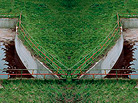women replicants (3) — minimal corrections — Alicja Karska and Aleksandra Went

Women Replicants is the cycle of exhibitions at the Small Gallery, which presents the output of some young Polish women artists. The title expression includes a revolutionary potential of generating unknown values, and turning against the system that created them. The opposition to formatting into rational frameworks and stiff, logically justified divisions, as well as the need of strong subjectification of a woman author in cultural strategies become a measure of truthfulness of the recalled stories. The discovering of the sense which is included in details becomes a basis for creation of a new language in which the women artists are not outsiders, but find a place where they can speak about themselves with a shift in relation to the current fallocentric order. Reaching for intimate experiences, they become engrossed in texts, decomposed in toxic secretions of their own net.

‘Women Replicants’ summary book of the cycle of exhibitions This book has been planned as a documentation of an exhibition cycle which was staged at the BWA Contemporary Art Gallery in Katowice in 2010. The works...

women replicants (4) — language as a licking tool — Justyna Gruszczyk and Bianka Rolando In his legendary action How to Explain Pictures to a Dead Hare? Joseph Beuys is whispering something in the ear of a dead hare carried in his arms....

women replicants (2) — greenhouse conditions — Natalia Bażowska, Kinga Bella, Magdalena Starska, Tatiana Wolska Apart from precise tools, delving into author’s visions requires patience and attention; the reading on the run is losing sense. Ideal work conditions...

women replicants (1) — callousness — Dorota Buczkowska ‘Lilith’, ‘Interror’, … Callousness abolishes consciousness, pain and defensive reflexes. As an operation it results from the need of stiffening and protection from too intense...

Works by Aleksandra Went and Alicja Karska seem to be resistant and tightly closed in their simplicity. Just like in the case of dreams about which we don’t know whether we had really dreamt or when only it seems to us that we dreamt them. The artists take the role of carers which are sensitised to the deconstruction of things. Exceeding the states of wear and tear of situations and places, they renew them and dust them off. They treat reality as ready stage scenery and try to care for it by means of observation.
They often reach to forgotten or unwanted places. Recording their video film Closed Circuit they let water flow into an unused pool, provoking circulation that changes nothing in principle. Waters flows in, partly filling the concrete inside of the pool, and then it is pumped out. Tracing the rhythm of its raising and lowering is connected with a fear of overflow, flood and sinking. There is something inexorable in that filling and refilling as if the tube were leaky or as if it were a wound which wouldn’t want to heal. We can feel that there is no chance to stop it. In this case the free movement, natural as breathing, is identical with the lack of control. Dirty water is overflowing again; in the end the very process starts to calm the onlooker.
In their video film Cinema Dream the artist show a girl dancing on a ruined stage against the background of squalid railway station in a small provincial town. Then they allow the protagonist to watch herself on the screen during a special projection organised only for her in an exclusive cinema hall. I thought I would be a dancer star in the future. It’s very pleasant to watch yourself on the screen, says the girl. It’s a grey autumn day in a dull place. In the background we can see the shabby-looking walls of the station from which it would be better to go away. The place from which we should escape as soon as possible is revived for a while with the unskilled dance of the girl, getting in significance.
Memorabilia is a video film in which the camera is recording photographs taken during holidays in the childhood. It skims their surface, trying to penetrate the memory about places like holiday homes, lakes and piers, thus trying to get the access code to the past. Its disturbed form reaches consciousness in fragments, what is typical for falling asleep in a nervous nap from which we are awakened every now and again. The image is disturbed and blurred. The movements of the camera, which are reanimating the shown situations are fluid and resemble the waving motion of the water. With the repetitions of sequences of images, sounds and movements they introduce into the original state of swinging and sensitivity to each, even the weakest sound.
Just like gentle rocking the baby in the arms or in a cradle aims at making the baby falling asleep, with simple means Karska and Went evoke the night state of consciousness, linking us with sensations which are not received that clearly and intensely during the day.
Curator: Marta Lisok





